#android 11 developer preview 2 release date
Explore tagged Tumblr posts
Text
Android 11 Developer Preview 2 is Here: A Look at All New Features
[ad_1]

The official icon of the Android 11 Developer Preview. (Illustration altered by News18.com)
From call screening to dedicated foldable phone refinements and better permission management, here are some more features that’ll be in Android 11.
News18.com
Last Updated: March 20, 2020, 3:36 PM IST
Yesterday, Google released Android 11 Developer Preview2, bringing…
View On WordPress
#android#android 11 best features#android 11 beta#android 11 developer preview#android 11 developer preview 2#android 11 developer preview 2 features#android 11 developer preview 2 how to download#android 11 developer preview 2 release date#android 11 development#android 11 features#android 11 first impressions#android 11 hidden features#android 11 how to install#android 11 launch date#android 11 new features#android 11 preview#android-11
0 notes
Text
Android 11 Will Likely Launch on September 8
Android 11 Will Likely Launch on September 8
The official icon of the Android 11 Developer Preview. (Illustration altered by News18.com)
Android 11’s launch date was glimpsed upon during a recent Google Smart Home Summit, and falls in line with when Android is launched as a stable build each year.
News18.com
Last Updated: July 9, 2020, 7:25 PM IST
Android 11, the next generation of one of the world’s most popular…
View On WordPress
#android#android 11#android 11 best features#android 11 beta#android 11 cool features#android 11 developer preview#android 11 developer preview 2#android 11 developer preview 2 features#android 11 download#Android 11 event#android 11 features#android 11 first impressions#android 11 hidden features#android 11 launch date#android 11 new features#android 11 preview#android 11 release date#android 11 review#android 11 update#Launch#September
0 notes
Text
How to download Android app on Windows 11
New Post has been published on https://www.asiatech.info/how-to-download-android-app-on-windows-11/
How to download Android app on Windows 11
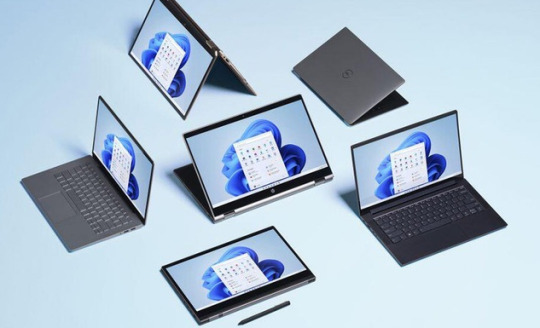
How to download Android app on Windows 11. In the end, Windows 11 operating system got the most popular Android app support. The question is how to use this facility.
Microsoft said in a statement that the Android app can be downloaded from the Amazon Appstore by going to the Microsoft Store. The preview will be available in the United States in a few days, the report said.
How to download Android app on Windows 11
There are certain hardware requirements when using the Android app on a Windows 11 PC. It has at least eight GB of RAM, SSD instead of hard drive and CPU that will support Android apps. Microsoft says it will be available in three steps to reach the Android app-
1. Open the Microsoft Store. Check if the store is up-to-date at this time. If not, update. In
2. Search for favorite apps or games.
3. Download via the Amazon Appstore.
You can take a look at thousands of other apps through the Amazon App Store preview. This includes mobile apps and games like Audible and Kindle. Microsoft says the partnership with Intel has made it possible to bring the desired benefits.
“Windows experience with input makes it seem like apps are part of Windows,” Pence Panay, Microsoft’s chief product officer, said in a statement.
In addition to the Appstore preview, Microsoft is also developing a taskbar. Windows, weather reports or clocks can be shared from the app opened through the new taskbar. It will have mute / unmute feature. This will help in making calls. There is a newly designed Notepad and media player.
Microsoft is gradually releasing Windows 11 in the market. However, support for Windows 10 will remain for several more years, the company said.
BNA / NEWS
1 note
·
View note
Photo
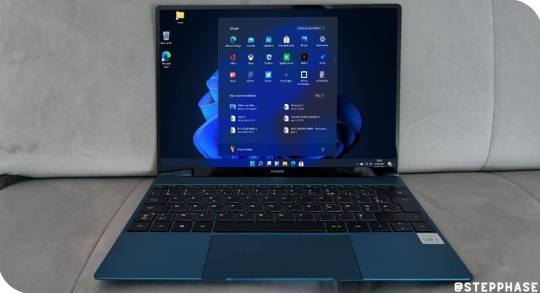
Windows 11: new features, release date, all about Microsoft's new OS
It is now a certainty: Windows 11 is well destined to replace Windows 10. For the occasion, Microsoft will hold a conference that promises to be epic on June 24th. In the meantime, a version of Windows 11 has already leaked to the web. The opportunity to take a quick tour of the owner and identify all the new features of Windows 11 ahead of time.
LATEST NEWS ON WINDOWS 11
While Microsoft had promised in 2015 that Windows 10 would be the ultimate version of its famous operating system, the Redmond giant has reversed its decision. After announcing in May 2021 that the next update of the system would be a real small revolution, we now know that behind this update is in fact ... Windows 11 !
Because yes, it is now a certainty: Windows 11 is the name that Microsoft gives to its new operating system. The installation ISO file that recently leaked to the web proves it. By the way, note that Microsoft is also currently waging war on sites that share links to the same ISO file , the editor of Redmond seeing a very bad eye the fact that its OS is already circulating on the Web so that nothing has yet been formalized.
But back to what interests us here: we have listed and analyzed all the new features that we can expect in this edition of the OS. And we have tried to answer the various questions that such a change implies: when will Windows 11 be released? Windows 10 going to disappear? And above all, will the new OS be free like its predecessor for those who already have a license of the old version?
WHAT'S NEW IN WINDOWS 11?
According to Satya Nadella, the current CEO of Microsoft, the next Windows is shaping up to be a big event: “Soon we will be sharing one of the most important Windows updates of the last decade, in order to deliver greater economic opportunities for developers and creators. I have used it for the last few months and am incredibly happy with the next generation of Windows, ”he said in May 2021.
The OS in question is of course Windows 11. Microsoft has not officially communicated on its release, we could remain for the moment at the stage of hypotheses concerning its content. If it is only that a version of Windows 11 has already leaked on the Web and that it allows getting a serious idea of the novelties of the operating system.
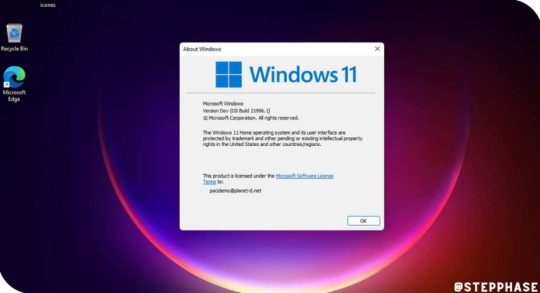
A NEW START MENU ON THE AGENDA
If Microsoft has not completely revamped Windows 11 compared to Windows 10, some big changes are still to be noted. Let's start with the Start menu . As shown in the screenshot below, the Windows icon that calls up the Start menu is no longer located on the left end of the Taskbar, but in its center. When you click on it, you immediately notice that the menu “floats” above the Windows icon, while in Windows 10, the menu was attached to it.
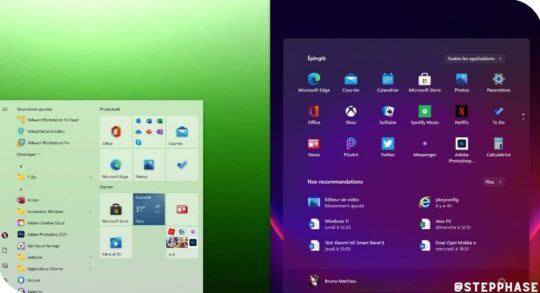
The Windows 10 Start menu on the left and the Windows 11 start menu on the right… That changes dramatically, doesn't it?
The icons present in the Start menu are presented in two very distinct categories: the first lists the shortcuts which are “pinned” to find them more quickly (the manipulation was already possible with Windows 10, but these icons were located in the right frame of the Start menu, while in Windows 11, they are located in the top frame). The second section deals with new applications installed or updated, as well as recently viewed files. These icons are located in a box entitled “Our recommendations”.
Pinned icons (in the top frame, therefore) can be removed or moved with a simple right click. As for the shortcuts appearing in the “Our recommendations” list (in the bottom frame, therefore), it is possible to delete them, open their directory in File Explorer, launch them using the browser, etc.
THE TASKBAR IS ALSO GETTING A FACELIFT
Just as it was possible to customize the Windows 10 taskbar in every way, it is possible to completely customize that of Windows 11. But rather than resorting to menus and sub-menus as shown in the screenshot below. Below, Microsoft has decided to do away with the cascading menus and group everything together in a single option. When you click the Settings option on the taskbar , you open the Settings application (which was already the case with Windows 10). From then on, you can completely customize the taskbar.
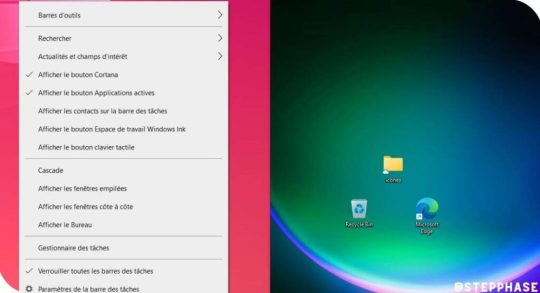
On the left is the rather “cluttered” Windows 10 customization menu. On the right, that of Windows 10, much easier to understand.
This is not the only novelty of the taskbar. The search field has also disappeared , to make way for an icon (a magnifying glass). There, as in Windows 10, you have access to a window allowing you to search locally or on the Web, to consult the top applications, to launch a specific request in the folders, music, photos, videos, etc. .
Note in passing that the taskbar and its icons can now adopt three different heights , against two for Windows 10. Currently, this change is only possible by adding a value to the registry. For the moment, the Taskbar Settings function no longer allows you to change the size of the icons, but we can bet that Microsoft will soon reintroduce this option to take advantage of the 3 different sizes.
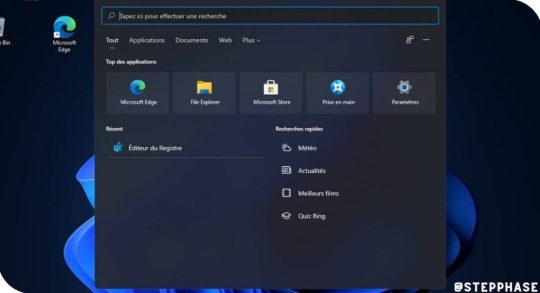
Another interesting novelty: the News and Fields of Interest function , integrated in build 21H1 of Windows 10, is now in the form of a Widget . As a result, Windows 10 no longer constantly displays the temperature on the icon in question. On the other hand, rather than being displayed in a small frame located on the right of the screen, the centers of interest, the sports results, the stock price and the weather are now displayed in a window to the left of the screen. This takes up half the screen and is much more visible (and readable) than the somewhat ridiculous frame, located at the bottom right of Windows 10. Note that the simple fact that Microsoft calls this section “Widgets ”Suggests that
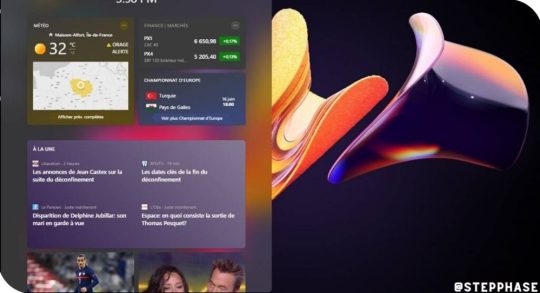
WINDOWS AND ICONS CHANGE THEIR LOOK
When you launch Windows 11 for the first time, you can't help but notice some major interface changes. All windows now have rounded edges. And it doesn't matter whether it's Explorer windows, Settings windows, the News & Interests Widget, or the many apps you may need to install: rounded edges are a must.
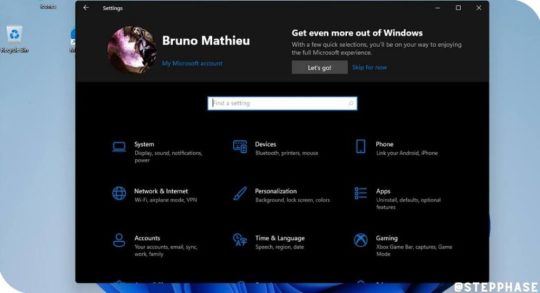
The icons Windows benefit from a helping youth. We had already been able to get a glimpse of it through a preview of Windows 10, it is now in effect for Windows 11. File Explorer thus benefits from new icons, as shown in the screenshot above.
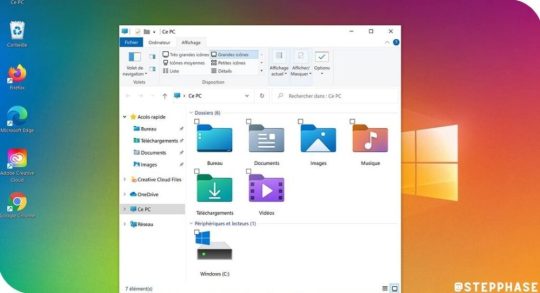
WINDOWS CAN NOW BE POSITIONED MORE EASILY
Until now, when you wanted to rearrange all windows on the Windows desktop, you had to right-click on the taskbar, and select one of the following options: Cascade, Show stacked windows, Show side-by-side windows, or View Desktop. This era is now over since, as mentioned above, the taskbar has only one option dedicated to its own settings.
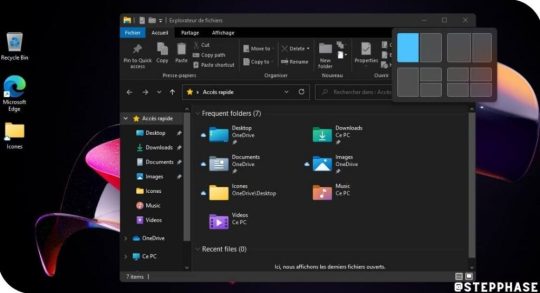
But then, are the window manager and its display possibilities under Windows 11? Microsoft decided to put them directly in the applications and Explorer windows, and that's pretty smart. By leaving the small cursor on the icon which opens a window on the whole screen, a new menu of icons appears . Thanks to it, we can now place a window on the left, on the right, rather downwards, rather downwards, in a “frame” of 4 windows… In short, more possibilities are offered to you as regards the arrangement of the windows. A little detail that changes your life.
SKYPE DISAPPEARS IN FAVOR OF MICROSOFT TEAMS
It's a small surprise: the first build available does not preinstall Skype and does away with all its integrations normally present in Windows 10. Everything indicates that Windows 11 is preparing to replace Skype with Microsoft Teams. Skype wouldn't go away completely, since it would still be possible to install it through the Microsoft Store or as an x86 app. But that would be a major change for this software that Microsoft acquired ten years ago and has always pushed to the fore, not hesitating to abandon MSN, its old messaging system.
WINDOWS 11 WOULD BE FASTER THAN WINDOWS 10
According to the first benchmarks, Windows 11 is already faster than Windows 10 and should see its performance improve with the updates. Obviously, for the moment, these results should be taken with all the necessary precautions, since the new version of the operating system has not been finalized.
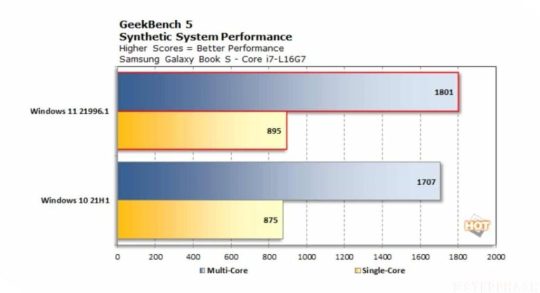
Nevertheless, if we are to believe the first tests carried out using software like Geekbench 5 or Cinebech R23, Windows 11 would be 2 to 8% faster than its predecessor . A figure which can reach 10% when we test the capabilities of the OS using the Chrome 91 browser. Microsoft would therefore have succeeded in optimizing its OS, without fundamentally changing the core. Note that the tests were performed on a Lakefield Core i7-L16G7 processor. From our side, we are waiting for the next generation of CPU and a definitive edition of Windows 11 to issue a final opinion on their relevance.
WHAT ARE THE FEATURES OF WINDOWS 11 THAT ARE STILL MISSING?
At the moment, the version of Windows 11 that Microsoft is working on is not yet finalized. The publisher has mainly relied on an “aesthetic” update of the OS, but new, deeper features should also emerge. For example, we are talking about full support for Android applications , without going through a third-party emulator like BlueStacks.
Another expected novelty of Windows 11: upon installation, Windows 11 offers you to “personalize your device” according to your uses (games, multimedia, creativity, work, etc.). If this function is present in the current beta of the OS, its effects are not visible for the moment. Again, we will have to wait for Microsoft to make an official presentation to find out more.
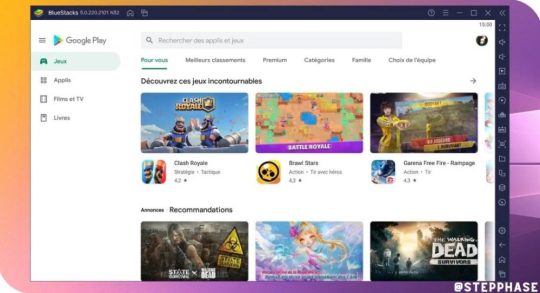
WHEN IS WINDOWS 11 RELEASED?
The new version of Windows 11 will be released in its final edition in 2021, that's for sure. The current version that has leaked seems finalized, or almost. Granted, it's still a bit early to judge, but we haven't encountered any major bugs with it. It may well be that Microsoft will release a finalized build during the summer. And that the most impatient rest assured: the Redmond giant obviously wants to broadcast a preview at the end of the conference on June 24, 2021 .
WHAT ARE THE DIFFERENT VERSIONS OF WINDOWS 11 AVAILABLE?
It is almost certain that Microsoft will apply its usual version program to Windows 11: home, professional and professional edition for work groups. This is also what the possibilities of installing Windows 11 from a USB key on a blank hard drive suggest.
On closer inspection, it also appears that Microsoft is planning to release an “SE” version of Windows 11. The difference with other versions of the OS? At first glance, nothing differentiates it from the classic version of the OS, except that it does not allow you to use Windows 11 locally. As a result, this may be an edition for online use only. We would therefore have to do with a version of Windows 11 developed for the Cloud, similar to what we find on the side of Google with Chrome OS.
WINDOWS 10 GOING TO DISAPPEAR?
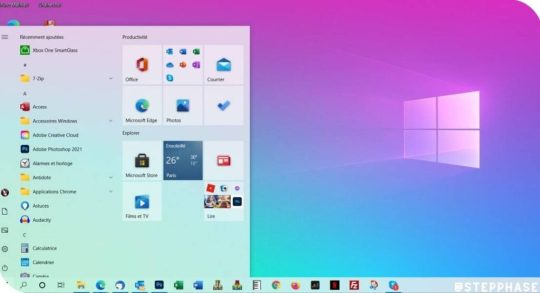
Launched in 2015, Windows 10 could bow out after 10 years of existence.
Here again, it is still a little early to judge the future of Windows 10 as long as no official announcement has been made. On the other hand, if we stick to Microsoft's usual policy regarding new versions of Windows, Windows 10 is not going to go away anytime soon.��Unless there is a final turnaround, the OS still has many long and beautiful years ahead of it. Windows XP for example has been maintained for almost 13 years, while Windows 7 has lasted for 11 years. Even the much-maligned Vista will have lived almost 11 years too.
Windows 10 arrived in its 6 th year, it is clear that its life cycle is not going to end anytime soon and he still has a few years to live, if that via updates security. This is what the operating system's software support page suggests. Microsoft is indeed talking about a deadline of October 14, 2025 for Windows 10 Home, Windows 10 Professional, Windows 10 Professional Education and Windows 10 Professional for Workstations.
https://youtu.be/MEv1EcTSQdA
HOW MUCH WILL WINDOWS 11 COST?
When Windows 10 was released in 2015, Microsoft “offered” all Windows 7 and Windows 8 users a license for its new operating system. This offer was only supposed to last for a year, but six later it is still active. We can reasonably hope that the editor of Redmond will repeat the operation with Windows 11: any holder of a license of Windows 7, 8.1, or Windows 10 should be entitled to a free migration to Windows 11.
We tested the operation which consists in using a serial number sometimes coming from Windows 7, sometimes from Windows 10. The registration of the license worked perfectly. As for the newcomers, they will probably have to put their hands in their pockets, knowing that at present, a full Windows 10 license costs between 145 and 259 euros depending on the version . It is likely that a Windows 11 license will show up at similar prices.
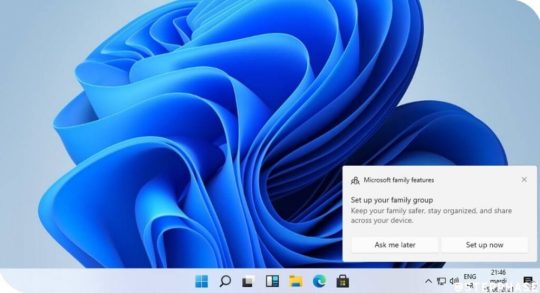
Finally, the last avenue to consider: the acquisition of a Windows subscription. A formula that would take on its full meaning with a Windows in the Cloud, the release of which also seems imminent. Recall that Microsoft already offers Office 365 in this format since 2011. If Windows 11 were to be declined in a remote version on the Cloud, it could well be that Microsoft launches such an offer.
Have you all enjoyed the Post!! Friends, your suggestions are always welcomed. Feel free and drop the message and also comment on the comment section, don’t hesitate to Contact us
Have a good day! See you all soon.
It may interest you
Windows 11: all about Microsoft's new OS like release date, new features
Microsoft Windows 10 Plans Complete UI refresh in 2021
The next generation Windows is coming
The best free video editing software for Windows
Linux - 8 Reasons Why Linux Beats Windows 10
#Stepphase #technologies #technology #tech #technews #techworld #techtrends #smartphone #apple #techupdates #futuretechnology #newtech #techgeek #technologynews #technologythesedays #smarttechnology #technologylover #technologytrends #technologyblog #gadgets #smartphone #gadget #marketing #digital #india #technologyisawesome #amazing #repost
0 notes
Text
Old Version Of Opera For Mac

Download the Opera browser for computer, phone, and tablet. Opera for Mac, Windows, Linux, Android, iOS. Free VPN, Ad blocker, built-in messengers. Is it possible to download an old version of Opera? For Mac OSX Lion? Download Old Version Opera The most full-featured Internet power tool on the market, Opera includes pop-up blocking, tabbed browsing, integrated searches, and advanced functions like Opera's groundbreaking E-mail program, RSS Newsfeeds and IRC chat. Archived Opera versions. Legacy version of Opera for Mac, Windows, and Linux can be found in the Opera archive. User agent string/ID. The user agent string for Chromium-based versions of Opera resembles the Chrome string with an additional browser signature: OPR/version major.version minor.build.patch (edition). Opera has released a new version of its browser for mobile devices. Opera Touch is a new project with two main purposes in mind: to provide an interface that lets us browse using a single hand and to integrate the official desktop client with the Android version through an internal chat where you can send yourself texts and links.
Opera Old Versions Download
Download Old Version Of Opera For Mac
Opera For Mac Download Latest Version
Download Old Version Of Opera For Mac
Old Versions Of Opera Browser
Last update: 2019-04-09
This document provides a quick historical reference to Opera versions, release dates, release streams, rendering engines, JavaScript engine, user agent/ID strings formats, features, and improvements.
The information below describes version history for Opera browsers built using the WebKit/Chromium rendering engine, Opera versions 15.0 and above. For information about the landmarks developed in Opera’s Presto rendering engine and related Opera browsers, please see Opera’s archived version history.
Version downloads
Opera downloads for Mac, Windows, and Linux platforms:
Latest Opera features, security and stability release (final)
Opera highly recommends all users to update to the latest release.
Opera for Windows, Mac, and Linux computers.
Opera pre-release channel builds
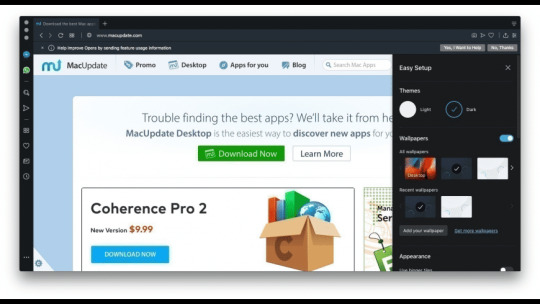
WARNING: These are pre-release builds. Please use them only on properly backed up computers. They contain the latest changes, but may also have severe known issues, including crashes and data loss situations. In fact, they may not work at all.
Archived Opera versions
Legacy version of Opera for Mac, Windows, and Linux can be found in the Opera archive.
User agent string/ID
The user agent string for Chromium-based versions of Opera resembles the Chrome string with an additional browser signature:
OPR/[version major].[version minor].[build].[patch] (edition)
This signifies the name of the browser (OPR) followed by a series of numbers denoting the build.
An edition may be included in the string, if the build is from the developer or beta pre-release streams, or if the build has been custom-made for an Opera partner. For example, a developer channel release of Opera’s partner build with Yandex may have a signature that looks like:
OPR/25.0.1614.18 (Edition developer-Yx)
The full user agent string looks similar to this:
Opera Old Versions Download
Mozilla/5.0 (X11; Linux x86_64) AppleWebKit/537.36 (KHTML, like Gecko) Chrome/50.0.2661.87 Safari/537.36 OPR/37.0.2178.31 (Edition beta)
This string will vary depending on your operating system and the build number you are using. Broken down, these objects mean:
Mozilla/[version]
Signifies the browser is Mozilla compatible.
(Operating system)
Signifies which platform and version of operating system the browser is running on.
AppleWebKit/[build]
Signifies the browser is WebKit compatible.
(Layout engine)
Signifies the layout engine used for rendering. KHTML is open-source and developed by the KDE project.
Chrome/[version, build, and patch]
Signifies the browser is Chrome compatible.
Safari/[build]
Signifies that the browser is Safari compatible.
OPR/[version, build, and patch]
Signifies the Opera browser signature (See above).
(Edition)
Signifies the edition of the Opera browser.
Download Old Version Of Opera For Mac
Feature facts
Opera For Mac Download Latest Version
Discover when an Opera feature was first introduced into the WebKit/Chromium based browsers (in alphabetical order).
FeatureIntroduced (date: version)Ad blocker2016-05-04: 37.0Animated PNG support2017-06-22: 46.0Autofill2013-08-27: 16.0Battery saver2016-06-08: 38.0Bookmarks bar2014-01-28: 19.0Bookmark manager2014-10-15: 25.0Chromecast support2018-01-04: 50.0Classic link selection (revived from Opera 12)2017-02-07: 43.0Click tab to scroll2018-02-07: 51.0Combined address and search bar2013-07-02: 15.0Copy page addresses2018-03-22: 52.0Crypto Wallet2019-04-09: 60.0 R3Cryptocurrency Mining Protection2018-01-04: 50.0Currency converter2016-13-12: 42.0Custom search2013-10-08: 17.0Dark theme2017-05-10: 45.0Desktop wallpaper in Opera2018-02-07: 51.0Discover (news feed)2013-07-02: 15.0Easy setup2017-11-08: 49.0Exportable bookmarks2017-08-09: 47.0Extensions2013-07-02: 15.0Geolocation2013-08-27: 16.0Heart menu2014-07-22: 23.0Instant Search2018-04-25: 52.0 R2Mac Touch Bar UI2017-03-21: 44.0Media access2013-11-19: 18.0Mouse gestures2013-07-02: 15.0My Flow2018-04-25: 52.0 R2News on Speed Dial2018-06-28: 54.0Off-Road mode2013-07-02: 15.0opera:flags2013-08-27: 16.0Opera Turbo (Turbo 2)2014-06-03: 22.0Optimized tab display2018-05-10: 53.0Pin tabs2013-10-08: 17.0Personalized newsreader2016-08-02: 39.0Rearrange extensions2017-11-08: 49.0Reset browser settings2018-02-07: 51.0Rocker gestures2013-11-19: 18.0Save web pages as PDF2018-01-04: 50.0Scroll to top of page by clicking active tab2018-09-25: 56.0Search pop up2016-08-02: 39.0Select multiple tabs2018-03-22: 52.0Sidebar messengers2017-05-10: 45.0Site settings in security badge pop-up2018-08-16: 55.0Snapshot2017-09-27: 48.0Snapshot with editing tools2017-11-08: 49.0Speed Dial2013-07-02: 15.0Stash2013-07-02: 15.0Sync services2015-03-10: 28.0Tab previews2014-09-02: 24.0Tab menu2015-01-27: 27.0Theme creation2014-01-28: 19.0Time zone converter2017-09-27: 48.0Unit converter2017-09-27: 48.0Update and Recovery page2018-06-28: 54.0URL suggestion removal2017-09-27: 48.0VPN (free, built-in)2016-09-20: 40.0VR Player2017-11-08: 49.0Warning before closing multiple tabs2019-01-23: 58.0WebAssembly2017-03-21: 44.0Web notifications2014-10-15: 25.0Video pop out2016-05-04: 37.0Volume control on video pop out2018-09-25: 56.0Zoom level indicator in address bar2018-09-25: 56.0
Download Old Version Of Opera For Mac
Version history
Old Versions Of Opera Browser
Opera 68Release date2020-04-22Rendering engineChromium 81JavaScript engineV8Features
Instagram in Sidebar
Search in tabs
Closing duplicate tabs
New security badges
Opera 67Release date2020-02-25Rendering engineChromium 80JavaScript engineV8Features
Workspaces
Duplicate tabs highlighter
Horizontal tab cycler
Sync – log in in the tab
Opera 66Release date2020-01-07Rendering engineChromium 79JavaScript engineV8Features
Extensions in Sidebar Pannel
Picture-in-picture
Opera 65 Release date2019-11-13Rendering engineChromium 78JavaScript engineV8Features
Bookmarks in the Sidebar Panel
Redesigned address bar
Opera 64Release date2019-10-07Rendering engineChromium 77JavaScript engineV8Features
Tracker blocking
Adblocking new flow
Opera 63Release date2019-08-20Rendering engineChromium 76JavaScript engineV8FeaturesOpera 62 – design updates to Reborn 3Release date2019-06-27Rendering engineChromium 75JavaScript engineV8Features
Crypto Wallet integration with Opera for Android and Opera Touch for iOS
Opera 60 – R3Release date2019-04-09Rendering engineChromium 73JavaScript engineV8Features
Crypto Wallet
Opera 59 betaRelease date(Final beta) 2019-02-28Rendering engineChromium 72JavaScript engineV8Features
Opera 60
Opera 58Release date2019-01-23Rendering engineChromium 71JavaScript engineV8Features
Warning before closing window with multiple tabs
Opera 57Release date2018-11-28Rendering engineChromium 70JavaScript engineV8Opera 56Release date2018-09-25Rendering engineChromium 69JavaScript engineV8Features
Scroll to top of page by clicking active tab
Zoom level indicator in address bar
Volume control on video pop out
Opera 55Release date2018-08-16Rendering engineChromium 68JavaScript engineV8Features
Site settings in security badge pop-up
Opera 54Release date2018-06-28Rendering engineChromium 67JavaScript engineV8Features
News on Speed Dial
Update and Recovery page
Opera 53Release date2018-05-10Rendering engineChromium 66JavaScript engineV8Features
Optimized tabs display
Opera 52 R2Release date2018-04-25Rendering engineChromium 65JavaScript engineV8Features
Instant Search
My Flow
Opera 52Release date2018-03-22Rendering engineChromium 65JavaScript engineV8Features
Select multiple tabs
Copy page addresses
Opera 51Release date2018-02-07Rendering engineChromium 64JavaScript engineV8Features
Click tab to scroll
Desktop wallpaper in Opera
Reset browser settings
Opera 50Release date2018-01-04Rendering engineChromium 63JavaScript engineV8Features
Cryptocurrency Mining Protection
Chromecast support
Save web pages as PDF
Opera 49Release date2017-11-08Rendering engineChromium 62JavaScript engineV8Features
Snapshot with editing tools
VR Player
Rearrange extensions
Easy setup
Opera 48Release date2017-09-27Rendering engineChromium 61JavaScript engineV8Features
Unit converter
Time zone converter
Snapshot
URL suggestion removal
Opera 47Release date2017-08-09Rendering engineChromium 60JavaScript engineV8Features
Exportable bookmarks
Opera 46Release date2017-06-22Rendering engineChromium 59JavaScript engineV8Features
Animated PNG support
Opera 45Release date2017-05-10Rendering engineChromium 58JavaScript engineV8Features
Sidebar messengers
Dark theme
Improved ad blocker
Refreshed UI
Opera 44Release date2017-03-21Rendering engineChromium 57JavaScript engineV8Features
Mac Touch Bar UI
WebAssembly
Opera 43Release date2017-02-07Rendering engineChromium 56JavaScript engineV8Features
Instant page loading
Profile Guided Optimization (PGO) for Windows
Classic link selection returns
Opera 42Release date2016-12-13Rendering engineChromium 55JavaScript engineV8Features
Built-in currency converter
Improved startup; smarter and faster
Newsreader shortcut in URL address bar
Network installer for Opera 64-bit
Opera 41Release date2016-10-25Rendering engineChromium 54JavaScript engineV8Features
Faster startup.
Longer battery time when video conferencing
Hardware-accelerated video pop-out
Personalized newsreader improvements
Stability enhancements and bug fixes
Opera 40Release date2016-09-20Rendering engineChromium 53JavaScript engineV8Features
Free, unlimited, no-log browser VPN service
Automatic battery saving
Chromecast support
Video pop-out improvements
Newsreader with RSS support
Stability enhancements and bug fixes
Opera 39Release date2016-08-02Rendering engineChromium 52JavaScript engineV8Features
Personalized newsreader
Improved video pop out
Customizable block lists to the native ad blocker
Search pop-up
Stability enhancements and bug fixes
Opera 38Release date2016-06-08Rendering engineChromium 51JavaScript engineV8Features
Battery saver
Ad blocker – add your own lists
Speed Dial improvements
Add your own photo as theme
Extension button visible in the Speed Dial side panel
Stability enhancements and bug fixes
Opera 37Release date2016-05-04Rendering engineChromium 50JavaScript engineV8Features
Built-in ad blocker makes webpages load faster
Video pop out displays video in a floating frame, always on top
Opera 36Release date2016-03-15Rendering engineChromium 49JavaScript engineV8Features
News feed on start page
Updated start page look and feel
Touch support for Windows 10
Opera 35Release date2016-02-02Rendering engineChromium 48JavaScript engineV8Features
Basic settings page
Mute button in tab bar
Active download warning on exit
Removal of bookmark duplicates
Optional separate search bar
Opera 34Release date2015-12-08Rendering engineChromium 47JavaScript engineV8Features
MSE audio playback
Share button on Mac
Opera 33Release date2015-10-27Rendering engineChromium 46JavaScript engineV8Features
Turbo 2 compression
Proprietary audio codec support
MIDI system-exclusive message settings
Protocol handler settings
Discontinued NPAPI support
Opera 32Release date2015-09-15Rendering engineChromium 45JavaScript engineV8Features
Animate themes
Sync passwords
Improved heart menu
Tree view for bookmark manager
Native Mac toolbars
Opera 31Release date2015-08-04Rendering engineChromium 44JavaScript engineV8Features
Widevine DRM support
Sync browsing history
Opera 30Release date2015-06-09Rendering engineChromium 43JavaScript engineV8Features
Extensions sidebar
Enhanced tab menu
Bookmarks trash folder
Sync browser settings
HTML5 MSE/H.264 support
Opera 29Release date2015-04-28Rendering engineChromium 42JavaScript engineV8Features
Improved start page look
Improved history manager
Sync open tabs
Sync and manage Speed Dial start pages
Audio indicator on the tab bar
Custom keyboard shortcuts
More mouse gestures
Opera 28Release date2015-03-10Rendering engineChromium 41JavaScript engineV8Features
Sync bookmarks with phones and tablets
Improved bookmark manager
Bookmarks suggestions in address bar
Increased H.264 support for Mac
Increased vibrancy for Mac menus
Opera 27Release date2015-01-27Rendering engineChromium 40JavaScript engineV8Features
Tab menu
Enhanced bookmark manager
Improved PPAPI support
Support for synthesized speech
New start page navigation
Opera 26Release date2014-12-03Rendering engineChromium 39JavaScript engineV8Features
Browser data import
Print preview
Bookmark sharing
Handoff support for Mac
Popover enhancement for Mac
Opera 25Release date2014-10-15Rendering engineChromium 38JavaScript engineV8Features
Bookmark manager
PDF viewer
Web notifications
Experimental start page
More support for HiDPI video and MP3 audio
Network installation on Mac
Opera 24Release date2014-09-02Rendering engineChromium 37JavaScript engineV8Features
Tab previews
HiDPI improvements on Windows
Darker window color for private browsing on Windows
Opera 23Release date2014-07-22Rendering engineChromium 36JavaScript engineV8Features
Heart menu in combined search and address bar
UI to allow blocked content in secure sessions
Opera 22Release date2014-06-03Rendering engineChromium 35JavaScript engineV8Features
HiDPI improvements
New default themes
Opera 21Release date2014-05-06Rendering engineChromium 34JavaScript engineV8Features
Aura implementation (Windows)
Option to display full URL in address bar
Broken padlock security badge
Opera 20Release date2014-03-04Rendering engineChromium 33JavaScript engineV8Features
Improved Stash screenshots
Draggable bookmarks
Speed Dial entry manual sizing
Opera 19Release date2014-01-28Rendering engineChromium 32JavaScript engineV8Features
Bookmarks bar
Theme creation
Advanced settings
Opera 18Release date2013-11-19Rendering engineChromium 31JavaScript engineV8Features
Media access
Rocker gestures
Theme installations via addons.opera.com
Opera 17Release date2013-10-08Rendering engineChromium 30JavaScript engineV8Features
Pinned tabs
Custom search
Startup behavior options
Opera 16Release date2013-08-27Rendering engineChromium 29JavaScript engineV8Features
opera:flags experimental test features
Geolocation and location sharing
Presentation mode for Mac
Task bar and start menu integration for Windows 7 and 8
Opera 15Release date2013-07-02Rendering engineChromium 28JavaScript engineV8Features
New rendering engine based on Chromium/Blink
New user interface
Improved site compatibility
Silent auto updates
Combined address and search bar
Enhanced Speed Dial
Stash
Discover
Off-Road mode

0 notes
Text
Google Android 11 Beta1 confirmed,final release expected in Q3

Usually Google launches the first public beta of a new Android version at its Google IO event in May, but this year the ongoing Covid-19 pandemic has caused Google IO to be canceled, leaving the Android 11 beta release date unclear. Now though, we have a date for it

Google has delayed the launch of Android 11 operating system’s first beta version due to the coronavirus crisis. The Android 11 Beta 1 will now go official on June 3 through an online event. Meanwhile, the technology giant has released a fourth developer preview of the upcoming operating system for the developers. Here are some of the key changes in the new schedule: Google is releasing a fourth Developer Preview on May 6 for testing and feedback. Beta 1 release moves to June 3. Google includes the final SDK and NDK APIs with this release and open up Google Play publishing for apps targeting Android 11. Beta 2 moves to July. Google reach Platform Stability with this release. Beta 3 moves to August and will include release candidate builds for final testing https://www.youtube.com/watch?v=04hjpFshguU We don’t know a whole lot about Android 11 yet, but developer previews have revealed some features, such as new security options that allow you to grant permissions to apps ‘just this once’, improved memory read speeds, and tweaks to the notification bar, recent apps screen, and button sizes. Read the full article
0 notes
Text
Google delays Android 11 by a month
Google today announced that it is extending the preview period of Android 11 by about a month. So instead of launching a beta this month, as it had previously planned, it’ll release a fourth developer preview today instead. The first beta will officially launch on June 3, during an Android-centric online event it’ll hold in lieu of its I/O developer conference.
“When we started planning Android 11, we didn’t expect the kinds of changes that would find their way to all of us, across nearly every region in the world,” Google’s Android team writes today. “These have challenged us to stay flexible and find new ways to work together, especially with our developer community. To help us meet those challenges we’re announcing an update to our release timeline.”
Google notes that it wants to meet the needs of the Android ecosystem, which has obviously started work on early app testing for Android 11 based on the company’s guidance, with the current environment during the Coronavirus pandemic and the other priorities that come with that. Delaying the release by a month seems like a reasonable approach in this context.
Google says developers should target the Beta 1 release date of June 3 for releasing a compatible app to gather feedback from the larger group of Android Beta users. And that group will be larger because like with previous releases, Google will make over-the-air updates available to users who opt in to the beta and have a compatible device. The list of compatible devices for the beta remains to be seen, but it’ll likely include all recent Pixel phones, starting with the Pixel 2.
youtube
0 notes
Text
2018-03-16 00 ANDROID now
ANDROID
Android Advices
Google Home now allows its users to set location-based reminders
Honor starts rolling out Android Oreo with EMUI 8.0 for Honor 7X to beta testers
Nubia V18 Smartphone to be announced with 5000mAh Battery on March 22
Asus ZenFone 4 Pro start receiving Android Oreo update
Honor 7C Smartphone Unveiled with Snapdragon 450 SoC & 18:9 Screen
Android Authority
Report: Mobile game spending 2x higher than PC/Mac game spending in 2017
Namaste! Google Assistant is now available in Hindi
Florence brings a tale of life and love to Android later this month (Update: Out now)
Google’s free, high-speed public Wi-Fi hotspots arrive in Mexico
Pre-order Lenovo’s stand-alone Daydream VR headset for $400
Android Central
Bigscreen is preparing a Gear VR launch soon
Huawei P20 Lite leaks in two hands-on videos ahead of March 27 launch
These inexpensive add-on lenses make the Pixel 2's camera even better
Everything you need to know about Sony Playlink
Taking a look back at the Tomb Raider series with the help of GameStash!
Android Developers
Android Developer Story: Homage finds success on Google Play with Start on Android
Google Play: Keep building (Stories from successful startup founders)
What's New in the Android P Preview
Adding Picture in Picture to your App
Designing the future of our dreams (Innovation track - Playtime EMEA 2017)
Android Guys
LG’s first Google Assistant smart speakers are now up for pre-order in the US
Google Camera’s Portrait Mode technology from the Pixel 2 goes open source
Our $19 speed reading bundle improves reading and comprehension
The five best Android tablets you can buy right now (March 2018)
OUKITEL shows off the rugged new WP5000 (Promoted)
Android Headlines
T-Mobile Breaks Two World Records With Samsung Galaxy S9
Deal: August Smart Lock – Second Generation for $124 – 3/15/18
“AT&T TV” Trademark Hints At DIRECTV & U-Verse Rebranding
Lenovo Mirage Solo Up For Pre-Orders With May Release Date
LG’s Google Assistant-Powered Speakers Now Up For Pre-Order
Android Police
ZeroLemon introduces Samsung Galaxy S9 and S9+ models of their industry-leading battery cases [Sponsored Post]
LG ThinQ Google Assistant Smart Display (WK9) up for pre-order for $297, its smart speaker (WK7) for $197
With over 50 billion apps scanned daily, Google’s Play Protect removed 39 million 'Potentially Harmful Apps' in 2017
[Qapla!] Duolingo's Klingon course is live, but only on the web for now
Google open sources image recognition AI model, VR audio tools
Droid Life
Nest Hello Doorbell, Yale Smartlock Now Available – New Temperature Sensor Up for Pre-Order
LG’s ThinQ Smart Display and Google Assistant Speaker Go Up for Pre-Order Too
Lenovo’s Stand-Alone Daydream VR Headset, VR180 Camera Up for Pre-Order With May 11 Ship Date
Galaxy S9 and S9+ Units Already Picking Up First Update With Face Unlock, Camera Fixes
Amazon’s Follow-Up Mode for Alexa Devices Would be Great With Google Home
Reddit Android
DuckDuckGo Privacy Browser 5.0.0 beta now supports tabs.
Google's partner for its 18 Megapixel 4.3” 1443 ppi 120 Hz OLED Display is LG
Honor 7X Android Oreo Beta with EMUI 8.0 rolls out starting today, brings Project Treble compatibility
Google Maps: Introducing “wheelchair accessible” routes in transit navigation
Android One Moto X4 receives 8.1 Oreo, w/ March security patch.
TechCrunch Android
Supernova promises to automatically convert Sketch mobile app designs into native UI code
Warner Bros. is pre-registering people for its Westworld game
Bose is carving out $50 million for startups using its new audio-focused AR tech
Android beats iOS in smartphone loyalty, study finds
Here’s the first developer preview of Android P
0 notes
Text
Google rolls out Android 11 for OnePlus, Xiaomi, Oppo and Realme flagships
After four developer previews of features and fixes, the stable build of Android 11 is finally here. Though Google rolled out it to Pixel devices initially, it’s said to be coming to few more handsets from other OEMs like Oppo, Xiaomi, Realme and OnePlus. Google introduced many privacy-focused and easy conversation features in the latest Android 11.
Android 11 Comes to Xiaomi, Oppo, Realme and OnePlus Phones
Ever since Google released the first developer preview of Android 11 back in July this year, it has been revamped with new features that make it easier for conversing, having more control over your privacy, an inbuilt screen recorder and bringing all smart settings one panel. While this has been applauded, it’s was available to only a few Pixel devices until today.
And with the official launch of Android 11, it’s rolling out to few more high-end phones of several OEMs like Oppo, Xiaomi, OnePlus and Realme. As per Verge’s report, Oppo’s X2 and Reno 3 are about to receive the stable Android 11 build. Also, the Realme X50 Pro, OnePlus 8 and 8, Mi 10 and 10 Pro will be getting this latest software along with Pixel 2, 3, 3A, 4 and 4A.
Also Read: Poco M2 launched with Helio G80 and 5000mAh battery
All these phones are testing their OS based on Android 11 beta till date. The new OS focuses on making the regular works on our phone easier than feeding new features. This is like introducing dedicating a conversation section in the notification panel for all your chats, Facebook’s Messenger-like chat bubbles hovering over the screen etc.
Also, Android 11 is made to integrate well with most of the smart devices in our home today, thus, Google set all the controls of those connected devices in a new section which can appear when user press and hold the power button. Further, it enhanced the power of controlling data privacy in Android 11, whereby the software forces every app to ask for permissions every time they’re opened, and can be set for short span as user desired.
More to read:
Xiaomi launches two Mi TV 4A Horizon Edition smart TVs in India
Samsung Galaxy S21 and Galaxy S21 Plus battery capacities leaked
Google to introduce a COVID-19 info layer to its Maps soon
MediaTek announces Dimensity 1000C chipset, to debut with LG Velvet 5G
from https://ift.tt/3m5duJX
0 notes
Text
Google launches Android 11 Beta 3, lets COVID-19 apps work with location off
Google today launched Android 11 Beta 3, the seventh and final preview of its next mobile OS version. Beta 3 puts Android 11 into release candidate status, which means Google is done putting the finishing touches on the new platform. This is the last chance developers have to make sure their apps and games are ready before Google starts rolling out Android 11 to businesses and consumers.
Android 11 has had a rocky beta schedule. Google launched Android 11 DP1 in February (the earliest it has ever released an Android developer preview), Android 11 DP2 in March, and Android 11 DP3 in April. Android 11 Beta 1 was supposed to arrive in May, but we got Android 11 DP4 as a stopgap measure. Beta 1 arrived in June followed by Beta 2 in July. Beta 1 would have normally been shown off at Google’s I/O developer conference, where the first Android beta typically debuts, but the event was canceled due to the coronavirus. #Android11: the Beta Launch Show was supposed to happen in lieu, but Google postponed and then ultimately canceled that as well due to protests over systemic racism and police brutality.
Every time we ask, Google insists that Android 11 is on schedule — the final is officially slated for Q3. Last month, Google accidentally let slip a September 8 launch date, though the company declined to comment when we pressed for confirmation.
You can get Android 11 Beta 3 now via the Android Beta Program or download it directly. Google will also be pushing an over-the-air (OTA) update for those on previous builds. The release includes the final SDK with system images for the Pixel 2, Pixel 2 XL, Pixel 3, Pixel 3 XL, Pixel 3a, Pixel 3a XL, Pixel 4, and Pixel 4 XL, as well as the official Android Emulator. If you buy a Pixel 4a, unveiled earlier this week and available as of August 20, you will also be able to install Android 11 Beta 3. These nine Pixel phones are a tiny slice of the over 2.5 billion monthly active Android devices — the main reason developers are exploring the new version in the first place. Google limited the first four Android 11 developer previews to those phones, but it has worked with its OEM partners to bring the betas to more devices.
Exposure Notification API
Although Android 11 has basically been done for months, Beta 3 does include one more change: the latest COVID-19 Exposure Notification API that Google developed with Apple. Last week, Google updated its version of the system with support for interoperability between countries. The company also announced that Android 11 apps will be able to use the API without needing to turn on the device location setting.
That exception, only for the Exposure Notification API, was designed “in such a way that apps using it can’t infer device location through Bluetooth scanning,” Google VP of engineering Dave Burke emphasized. “To protect user privacy, all other apps will still be prohibited from performing Bluetooth scanning unless the device location setting is on and the user has granted them location permission.”
Release Candidate
Beta 2 brought the Platform Stability milestone, which finalized the Android 11 app-facing surfaces and behaviors, including SDK and NDK APIs, system behaviors, and restrictions on non-SDK interfaces that may affect apps. Beta 3 includes the official API 30 SDK and build tools for Android Studio, plus “the latest fixes and optimizations,” Google says.
Developers should install their production app on a device or emulator running Android 11, test all the user flows and features, and make sure none of Android 11’s changes break anything. With Android 11 now just a month away, Burke called on all Android app and game developers to “finish your compatibility testing and publish your updates soon. For SDK, library, tools, and game engine developers, it’s even more important to release a compatible version right away, since your downstream app and game developers may be blocked until they receive your updates.”
While these changes will only affect Android 11 users, either those who updated to it or purchased a new device, that still translates to millions of devices. Before exploring the new APIs and capabilities, developers should start by testing their current app and releasing a compatibility update.
Android 11 features
Google has been trickling out new features for months now. Android 11 Developer Preview 1 brought 5G experiences, people and conversations improvements, Neural Networks API 1.3, privacy and security features, Google Play System updates, app compatibility, connectivity, image and camera improvements, and low latency tweaks. DP2 built on those with foldable, call screening, and more Neural Networks API improvements. DP3 included app exit reasons updates, GWP-ASan heap analysis, Android Debug Bridge Incremental, wireless debugging, and data access auditing. DP4 didn’t have any new features.
Beta 1 more than compensated with new messaging functionality (conversation, notifications, Bubbles, consolidated keyboard suggestions, and Voice Access), smart home controls for devices and media, and privacy features (one-time permission, permissions auto-reset, background location changes, and more Google Play System Updates modules). We covered Beta 2 and Beta 3 above — they were more about stability and final touches than new features.
While the developer previews are only meant for, well, developers, early adopters and anyone interested in beta software can try Android 11 now. In return, Google is asking that you give feedback and report bugs.
Android 11 beta schedule
Last year, there were six betas. This year, there have been four developer previews and three betas.
Here’s the Android 11 schedule:
February: Developer Preview 1 (Early baseline build focused on developer feedback, with new features, APIs, and behavior changes.)
March: Developer Preview 2 (Incremental update with additional features, APIs, and behavior changes.)
April: Developer Preview 3 (Incremental update for stability and performance.)
May: Developer Preview 4 (App compatibility and performance improvements.)
June: Beta 1 (Final SDK and NDK APIs; Google Play publishing open for apps targeting Android 11.)
July: Beta 2 (Platform Stability milestone. Final APIs and behaviors.)
August: Beta 3 (Release candidate build.)
Q3: Final release (Android 11 release to AOSP and ecosystem.)
If you haven’t started testing yet, now is the time. After you’ve downloaded Beta 3, update your Android Studio environment with the SDK (setup guide). Then install your current production app and test the user flows. For a complete rundown on what’s new, check the API overview, API reference, and behavior changes.
Source link
قالب وردپرس
from World Wide News https://ift.tt/3guzRW9
0 notes
Text
Android 11 Beta 2 and Platform Stability
Posted by Dave Burke, VP of Engineering
A few weeks ago we unwrapped the first Beta of Android 11 with a focus on people, controls, and privacy. As we highlighted in the #Android11Beta Launch, we’re making Android more people-centric and expressive, helping users control their smart devices, and giving them even more control over sensitive permissions. Developers can use APIs like Conversations, Bubbles, Device Controls, and Media Controls, to integrate these experiences into their apps.
Today we’re pushing out the second Beta of Android 11 for you to try. This release takes us to the Platform Stability milestone, which means that Android 11’s APIs and behaviors are finalized. For developers, it’s time to get started on your final compatibility updates and publish them in time for the official release later in Q3.
This week’s theme in #11 Weeks of Android is Android 11 Compatibility and we’ll be sharing helpful content and materials all week. You can find them on the #11 Weeks page or follow Android Developers on Twitter and Youtube.
You can get Beta 2 today on your Pixel 2, 3, 3a, and 4 device by enrolling here for over-the-air updates, and downloads are also available. If you previously enrolled for Beta 1, you will automatically get the over-the-air update. Let us know what you think, and thanks for the feedback you’ve provided so far!
Platform Stability
Beta 2 brings Android 11 to Platform Stability, a new release milestone that we added this year just for developers, based on your feedback.
Platform Stability means that all app-facing surfaces and behaviors are now final in Android 11. This includes not only final SDK and NDK APIs, but also final system behaviors and restrictions on non-SDK interfaces that may affect apps. So from Beta 2, you can release compatibility updates with confidence that the platform won’t change. More on the timeline is here.
With the platform now stable, we’re encouraging all app and game developers to start your final compatibility testing and publish your updates ahead of the final release.
For all SDK, library, tools, and game engine developers, it’s even more important to start testing now and release your compatible updates as soon as possible – your downstream app and game developers may be blocked until they receive your updates. When you’ve released a compatible update, be vocal and let developers know!
youtube
Why app compatibility is important
For Android, the term app compatibility means that your app runs properly on a specific version of the platform, typically the latest version. You can check this right now by installing your production app on a device or emulator running Android 11. Just test all of the user flows and features, and if the app looks and runs properly, then you’re done, it’s compatible!
It sounds simple, but sometimes there’s more to it. With each release, we make integral changes that improve privacy and security, as well as implement changes that evolve the overall user experience across the OS. Sometimes these can affect your apps, so it’s important to take a look at the behavior changes and test against them, then publish the compatible update to users. It’s a basic but critical level of quality.
App compatibility comes into play as users update to the latest version of Android, whether they’ve purchased a new device or installed an update on their current device. They’re excited to explore the latest version of Android, and they want to experience it with their favorite apps. If the apps don’t work properly, it’s a major issue - for users and for all of us.
So while there are a ton of new APIs and capabilities to explore, and more changes to consider when you’re ready to change your app’s targeting, start by testing your current app and releasing a compatible update first.
Updates to Pixel and other devices will get started as soon as Android 11 reaches the final release to Android Open Source Project (AOSP), which we expect later in Q3. Multiple partner devices are also in active public previews now to support your compatibility testing.
Making app compatibility easier in Android 11
With each release, we’re working to reduce the work you’ll need to do to get your apps ready. In Android 11, we’ve added new processes, developer tools, and release milestones to minimize the impact of platform updates and make it easier for apps to stay compatible.
Minimizing the impact of behavior changes - we’re making a conscious effort to minimize platform changes that could affect apps by making them opt-in, wherever possible, until you set targetSdkVersion to Android 11 in your app. If you are distributing through Google Play, you’ll have more than a year to opt-in to these changes.
Easier testing and debugging - To help you test for compatibility, we’ve made many of the breaking changes toggleable - meaning that you can force-enable or disable the changes individually from Developer options or adb. With this change, there’s no longer a need to change targetSdkVersion or recompile your app for basic testing. Check out the details here.
App compatibility toggles in Developer options.
Restrictions on non-SDK interfaces - as part of our ongoing effort to gradually move developers away from non-SDK APIs, we’ve updated the lists of restricted non-SDK interfaces, and as always your feedback and requests for public API equivalents are welcome.
Dynamic resource loader - As part of their migration away from non-SDK interfaces, developers asked us for a public API to load resources and assets dynamically at runtime. We’ve now added a Resource Loader framework in Android 11, and thank you to the developers who gave us this input!
Platform stability milestone - As mentioned, this is a new milestone we’ve added to our release process to give developers a clear date for final changes. It includes not only final SDK/NDK APIs, but also final internal APIs and system behaviors that may affect apps.
Get your apps ready for Android 11!
Now that Android 11 is stable, make your apps compatible as soon as possible. Here’s how to do it.
For testing your current app, start with the behavior changes for all apps to see where it could be affected. Here are the top changes (these apply regardless of your app’s targetSdkVersion):
One-time permission - Users can now grant single-use permission to access location, device microphone and camera. Details here.
External storage access - Apps can no longer access other apps’ files in external storage. Details here.
Scudo hardened allocator - Now the heap memory allocator for native code in apps. Details here.
File descriptor sanitizer - Now enabled by default to detect file descriptor handling issues for native code in apps. Details here.
Remember to test the libraries and SDKs in your app for compatibility. If you find an issue, try updating to the latest version of the SDK, or reach out to the developer for help.
Later, after you’ve published the compatible version of your current app, you can start the process of updating your app’s targetSdkVersion. Review the behavior changes for Android 11 apps and try the compatibility framework to help find impacts. Here are some of the top changes to test for (these apply only to targetSdkVersion 30+):
Scoped storage - New storage restrictions, behaviors, and APIs for apps reading and writing files. Details here.
Background location - Changes to how apps request background location and how users grant it. Details here.
Package visibility - Changes to how apps can query and interact with other installed apps. Details here.
Compressed resource files - Apps can’t be installed or updated if they contain a compressed resources.arsc file, or if the file is not aligned on a 4-byte boundary. Details here.
APK Signature Scheme v2 - Apps must now be signed using APK Signature Scheme v2 or higher. Details here.
Heap pointer tagging - For 64-bit processes, native heap allocations have a tag set in the top byte of the pointer that should not be modified by apps. Details here.
During testing, watch for uses of restricted non-SDK interfaces in your app and move those to public SDK equivalents instead. You can read about the restricted APIs here.
Explore the new features and APIs
As soon as you’re ready, dive into Android 11 and learn about the new experiences you can build. Our #Android11 Beta post has a recap of new features for developers, and you can also visit the Beta Launch page to see talks from the Android team on what’s new in their areas.
Android Studio also has new features for Android 11 also, to improve your productivity and workflow, such as ADB incremental for faster installs of large APKs, and additional nullability annotations on platform APIs. You can give these a try by downloading the latest Android Studio Beta or Canary version. Instructions for configuring Android Studio for Android 11 are here.
For complete details on Android 11 features and APIs, visit the Android 11 developer site.
How do I get Beta 2?
It’s easy! You can enroll here to get Android 11 Beta updates over-the-air for Pixel 2, 3, 3a, and 4 devices. Alternatively, give Android Flash Tool a try for easy on-demand updates, and downloadable system images are also available. If you don’t have a Pixel device, you can use the Android Emulator in Android Studio or try a GSI image to run Android 11 on supported Treble-compliant devices.
As always, your feedback is critical, so please let us know what you think. You can use our hotlists for filing platform issues (including privacy and behavior changes), app compatibility issues, and third-party SDK issues. You’ve shared great feedback with us so far – thank you!
Android 11 compatibility week
This week in #11 Weeks of Android, we’re highlighting Android 11 Compatibility, a theme that’s important for all developers now that the platform has reached stability.
We’re sharing resources to help you with compatibility testing here, and you can follow Android Developers on Twitter and Youtube to catch helpful content and materials in this area all this week!
Also, the Android engineering team will host a Reddit AMA on r/androiddev tomorrow, July 9 at 12:00PM PST, to answer your technical questions about Android 11. See this post for details and to submit your questions.
Android 11 Beta 2 and Platform Stability published first on https://phonetracking.tumblr.com/ Android 11 Beta 2 and Platform Stability published first on https://leolarsonblog.tumblr.com/
0 notes
Text
Android 11 Beta 2 and Platform Stability
Posted by Dave Burke, VP of Engineering
A few weeks ago we unwrapped the first Beta of Android 11 with a focus on people, controls, and privacy. As we highlighted in the #Android11Beta Launch, we’re making Android more people-centric and expressive, helping users control their smart devices, and giving them even more control over sensitive permissions. Developers can use APIs like Conversations, Bubbles, Device Controls, and Media Controls, to integrate these experiences into their apps.
Today we’re pushing out the second Beta of Android 11 for you to try. This release takes us to the Platform Stability milestone, which means that Android 11’s APIs and behaviors are finalized. For developers, it’s time to get started on your final compatibility updates and publish them in time for the official release later in Q3.
This week’s theme in #11 Weeks of Android is Android 11 Compatibility and we’ll be sharing helpful content and materials all week. You can find them on the #11 Weeks page or follow Android Developers on Twitter and Youtube.
You can get Beta 2 today on your Pixel 2, 3, 3a, and 4 device by enrolling here for over-the-air updates, and downloads are also available. If you previously enrolled for Beta 1, you will automatically get the over-the-air update. Let us know what you think, and thanks for the feedback you’ve provided so far!
Platform Stability
Beta 2 brings Android 11 to Platform Stability, a new release milestone that we added this year just for developers, based on your feedback.
Platform Stability means that all app-facing surfaces and behaviors are now final in Android 11. This includes not only final SDK and NDK APIs, but also final system behaviors and restrictions on non-SDK interfaces that may affect apps. So from Beta 2, you can release compatibility updates with confidence that the platform won’t change. More on the timeline is here.
With the platform now stable, we’re encouraging all app and game developers to start your final compatibility testing and publish your updates ahead of the final release.
For all SDK, library, tools, and game engine developers, it’s even more important to start testing now and release your compatible updates as soon as possible -- your downstream app and game developers may be blocked until they receive your updates. When you’ve released a compatible update, be vocal and let developers know!
youtube
Why app compatibility is important
For Android, the term app compatibility means that your app runs properly on a specific version of the platform, typically the latest version. You can check this right now by installing your production app on a device or emulator running Android 11. Just test all of the user flows and features, and if the app looks and runs properly, then you’re done, it’s compatible!
It sounds simple, but sometimes there’s more to it. With each release, we make integral changes that improve privacy and security, as well as implement changes that evolve the overall user experience across the OS. Sometimes these can affect your apps, so it’s important to take a look at the behavior changes and test against them, then publish the compatible update to users. It’s a basic but critical level of quality.
App compatibility comes into play as users update to the latest version of Android, whether they’ve purchased a new device or installed an update on their current device. They’re excited to explore the latest version of Android, and they want to experience it with their favorite apps. If the apps don’t work properly, it’s a major issue - for users and for all of us.
So while there are a ton of new APIs and capabilities to explore, and more changes to consider when you’re ready to change your app’s targeting, start by testing your current app and releasing a compatible update first.
Updates to Pixel and other devices will get started as soon as Android 11 reaches the final release to Android Open Source Project (AOSP), which we expect later in Q3. Multiple partner devices are also in active public previews now to support your compatibility testing.
Making app compatibility easier in Android 11
With each release, we’re working to reduce the work you’ll need to do to get your apps ready. In Android 11, we’ve added new processes, developer tools, and release milestones to minimize the impact of platform updates and make it easier for apps to stay compatible.
Minimizing the impact of behavior changes - we’re making a conscious effort to minimize platform changes that could affect apps by making them opt-in, wherever possible, until you set targetSdkVersion to Android 11 in your app. If you are distributing through Google Play, you’ll have more than a year to opt-in to these changes.
Easier testing and debugging - To help you test for compatibility, we’ve made many of the breaking changes toggleable - meaning that you can force-enable or disable the changes individually from Developer options or adb. With this change, there’s no longer a need to change targetSdkVersion or recompile your app for basic testing. Check out the details here.
App compatibility toggles in Developer options.
Restrictions on non-SDK interfaces - as part of our ongoing effort to gradually move developers away from non-SDK APIs, we’ve updated the lists of restricted non-SDK interfaces, and as always your feedback and requests for public API equivalents are welcome.
Dynamic resource loader - As part of their migration away from non-SDK interfaces, developers asked us for a public API to load resources and assets dynamically at runtime. We’ve now added a Resource Loader framework in Android 11, and thank you to the developers who gave us this input!
Platform stability milestone - As mentioned, this is a new milestone we’ve added to our release process to give developers a clear date for final changes. It includes not only final SDK/NDK APIs, but also final internal APIs and system behaviors that may affect apps.
Get your apps ready for Android 11!
Now that Android 11 is stable, make your apps compatible as soon as possible. Here’s how to do it.
For testing your current app, start with the behavior changes for all apps to see where it could be affected. Here are the top changes (these apply regardless of your app’s targetSdkVersion):
One-time permission - Users can now grant single-use permission to access location, device microphone and camera. Details here.
External storage access - Apps can no longer access other apps’ files in external storage. Details here.
Scudo hardened allocator - Now the heap memory allocator for native code in apps. Details here.
File descriptor sanitizer - Now enabled by default to detect file descriptor handling issues for native code in apps. Details here.
Remember to test the libraries and SDKs in your app for compatibility. If you find an issue, try updating to the latest version of the SDK, or reach out to the developer for help.
Later, after you’ve published the compatible version of your current app, you can start the process of updating your app's targetSdkVersion. Review the behavior changes for Android 11 apps and try the compatibility framework to help find impacts. Here are some of the top changes to test for (these apply only to targetSdkVersion 30+):
Scoped storage - New storage restrictions, behaviors, and APIs for apps reading and writing files. Details here.
Background location - Changes to how apps request background location and how users grant it. Details here.
Package visibility - Changes to how apps can query and interact with other installed apps. Details here.
Compressed resource files - Apps can’t be installed or updated if they contain a compressed resources.arsc file, or if the file is not aligned on a 4-byte boundary. Details here.
APK Signature Scheme v2 - Apps must now be signed using APK Signature Scheme v2 or higher. Details here.
Heap pointer tagging - For 64-bit processes, native heap allocations have a tag set in the top byte of the pointer that should not be modified by apps. Details here.
During testing, watch for uses of restricted non-SDK interfaces in your app and move those to public SDK equivalents instead. You can read about the restricted APIs here.
Explore the new features and APIs
As soon as you’re ready, dive into Android 11 and learn about the new experiences you can build. Our #Android11 Beta post has a recap of new features for developers, and you can also visit the Beta Launch page to see talks from the Android team on what’s new in their areas.
Android Studio also has new features for Android 11 also, to improve your productivity and workflow, such as ADB incremental for faster installs of large APKs, and additional nullability annotations on platform APIs. You can give these a try by downloading the latest Android Studio Beta or Canary version. Instructions for configuring Android Studio for Android 11 are here.
For complete details on Android 11 features and APIs, visit the Android 11 developer site.
How do I get Beta 2?
It’s easy! You can enroll here to get Android 11 Beta updates over-the-air for Pixel 2, 3, 3a, and 4 devices. Alternatively, give Android Flash Tool a try for easy on-demand updates, and downloadable system images are also available. If you don't have a Pixel device, you can use the Android Emulator in Android Studio or try a GSI image to run Android 11 on supported Treble-compliant devices.
As always, your feedback is critical, so please let us know what you think. You can use our hotlists for filing platform issues (including privacy and behavior changes), app compatibility issues, and third-party SDK issues. You've shared great feedback with us so far -- thank you!
Android 11 compatibility week
This week in #11 Weeks of Android, we’re highlighting Android 11 Compatibility, a theme that’s important for all developers now that the platform has reached stability.
We’re sharing resources to help you with compatibility testing here, and you can follow Android Developers on Twitter and Youtube to catch helpful content and materials in this area all this week!
Also, the Android engineering team will host a Reddit AMA on r/androiddev tomorrow, July 9 at 12:00PM PST, to answer your technical questions about Android 11. See this post for details and to submit your questions.
Android 11 Beta 2 and Platform Stability published first on https://phonetracking.tumblr.com/
0 notes
Text
Android 11 Beta 2 and Platform Stability
Posted by Dave Burke, VP of Engineering
A few weeks ago we unwrapped the first Beta of Android 11 with a focus on people, controls, and privacy. As we highlighted in the #Android11Beta Launch, we’re making Android more people-centric and expressive, helping users control their smart devices, and giving them even more control over sensitive permissions. Developers can use APIs like Conversations, Bubbles, Device Controls, and Media Controls, to integrate these experiences into their apps.
Today we’re pushing out the second Beta of Android 11 for you to try. This release takes us to the Platform Stability milestone, which means that Android 11’s APIs and behaviors are finalized. For developers, it’s time to get started on your final compatibility updates and publish them in time for the official release later in Q3.
This week’s theme in #11 Weeks of Android is Android 11 Compatibility and we’ll be sharing helpful content and materials all week. You can find them on the #11 Weeks page or follow Android Developers on Twitter and Youtube.
You can get Beta 2 today on your Pixel 2, 3, 3a, and 4 device by enrolling here for over-the-air updates, and downloads are also available. If you previously enrolled for Beta 1, you will automatically get the over-the-air update. Let us know what you think, and thanks for the feedback you’ve provided so far!
Platform Stability
Beta 2 brings Android 11 to Platform Stability, a new release milestone that we added this year just for developers, based on your feedback.
Platform Stability means that all app-facing surfaces and behaviors are now final in Android 11. This includes not only final SDK and NDK APIs, but also final system behaviors and restrictions on non-SDK interfaces that may affect apps. So from Beta 2, you can release compatibility updates with confidence that the platform won’t change. More on the timeline is here.
With the platform now stable, we’re encouraging all app and game developers to start your final compatibility testing and publish your updates ahead of the final release.
For all SDK, library, tools, and game engine developers, it’s even more important to start testing now and release your compatible updates as soon as possible -- your downstream app and game developers may be blocked until they receive your updates. When you’ve released a compatible update, be vocal and let developers know!
youtube
Why app compatibility is important
For Android, the term app compatibility means that your app runs properly on a specific version of the platform, typically the latest version. You can check this right now by installing your production app on a device or emulator running Android 11. Just test all of the user flows and features, and if the app looks and runs properly, then you’re done, it’s compatible!
It sounds simple, but sometimes there’s more to it. With each release, we make integral changes that improve privacy and security, as well as implement changes that evolve the overall user experience across the OS. Sometimes these can affect your apps, so it’s important to take a look at the behavior changes and test against them, then publish the compatible update to users. It’s a basic but critical level of quality.
App compatibility comes into play as users update to the latest version of Android, whether they’ve purchased a new device or installed an update on their current device. They’re excited to explore the latest version of Android, and they want to experience it with their favorite apps. If the apps don’t work properly, it’s a major issue - for users and for all of us.
So while there are a ton of new APIs and capabilities to explore, and more changes to consider when you’re ready to change your app’s targeting, start by testing your current app and releasing a compatible update first.
Updates to Pixel and other devices will get started as soon as Android 11 reaches the final release to Android Open Source Project (AOSP), which we expect later in Q3. Multiple partner devices are also in active public previews now to support your compatibility testing.
Making app compatibility easier in Android 11
With each release, we’re working to reduce the work you’ll need to do to get your apps ready. In Android 11, we’ve added new processes, developer tools, and release milestones to minimize the impact of platform updates and make it easier for apps to stay compatible.
Minimizing the impact of behavior changes - we’re making a conscious effort to minimize platform changes that could affect apps by making them opt-in, wherever possible, until you set targetSdkVersion to Android 11 in your app. If you are distributing through Google Play, you’ll have more than a year to opt-in to these changes.
Easier testing and debugging - To help you test for compatibility, we’ve made many of the breaking changes toggleable - meaning that you can force-enable or disable the changes individually from Developer options or adb. With this change, there’s no longer a need to change targetSdkVersion or recompile your app for basic testing. Check out the details here.
App compatibility toggles in Developer options.
Restrictions on non-SDK interfaces - as part of our ongoing effort to gradually move developers away from non-SDK APIs, we’ve updated the lists of restricted non-SDK interfaces, and as always your feedback and requests for public API equivalents are welcome.
Dynamic resource loader - As part of their migration away from non-SDK interfaces, developers asked us for a public API to load resources and assets dynamically at runtime. We’ve now added a Resource Loader framework in Android 11, and thank you to the developers who gave us this input!
Platform stability milestone - As mentioned, this is a new milestone we’ve added to our release process to give developers a clear date for final changes. It includes not only final SDK/NDK APIs, but also final internal APIs and system behaviors that may affect apps.
Get your apps ready for Android 11!
Now that Android 11 is stable, make your apps compatible as soon as possible. Here’s how to do it.
For testing your current app, start with the behavior changes for all apps to see where it could be affected. Here are the top changes (these apply regardless of your app’s targetSdkVersion):
One-time permission - Users can now grant single-use permission to access location, device microphone and camera. Details here.
External storage access - Apps can no longer access other apps’ files in external storage. Details here.
Scudo hardened allocator - Now the heap memory allocator for native code in apps. Details here.
File descriptor sanitizer - Now enabled by default to detect file descriptor handling issues for native code in apps. Details here.
Remember to test the libraries and SDKs in your app for compatibility. If you find an issue, try updating to the latest version of the SDK, or reach out to the developer for help.
Later, after you’ve published the compatible version of your current app, you can start the process of updating your app's targetSdkVersion. Review the behavior changes for Android 11 apps and try the compatibility framework to help find impacts. Here are some of the top changes to test for (these apply only to targetSdkVersion 30+):
Scoped storage - New storage restrictions, behaviors, and APIs for apps reading and writing files. Details here.
Background location - Changes to how apps request background location and how users grant it. Details here.
Package visibility - Changes to how apps can query and interact with other installed apps. Details here.
Compressed resource files - Apps can’t be installed or updated if they contain a compressed resources.arsc file, or if the file is not aligned on a 4-byte boundary. Details here.
APK Signature Scheme v2 - Apps must now be signed using APK Signature Scheme v2 or higher. Details here.
Heap pointer tagging - For 64-bit processes, native heap allocations have a tag set in the top byte of the pointer that should not be modified by apps. Details here.
During testing, watch for uses of restricted non-SDK interfaces in your app and move those to public SDK equivalents instead. You can read about the restricted APIs here.
Explore the new features and APIs
As soon as you’re ready, dive into Android 11 and learn about the new experiences you can build. Our #Android11 Beta post has a recap of new features for developers, and you can also visit the Beta Launch page to see talks from the Android team on what’s new in their areas.
Android Studio also has new features for Android 11 also, to improve your productivity and workflow, such as ADB incremental for faster installs of large APKs, and additional nullability annotations on platform APIs. You can give these a try by downloading the latest Android Studio Beta or Canary version. Instructions for configuring Android Studio for Android 11 are here.
For complete details on Android 11 features and APIs, visit the Android 11 developer site.
How do I get Beta 2?
It’s easy! You can enroll here to get Android 11 Beta updates over-the-air for Pixel 2, 3, 3a, and 4 devices. Alternatively, give Android Flash Tool a try for easy on-demand updates, and downloadable system images are also available. If you don't have a Pixel device, you can use the Android Emulator in Android Studio or try a GSI image to run Android 11 on supported Treble-compliant devices.
As always, your feedback is critical, so please let us know what you think. You can use our hotlists for filing platform issues (including privacy and behavior changes), app compatibility issues, and third-party SDK issues. You've shared great feedback with us so far -- thank you!
Android 11 compatibility week
This week in #11 Weeks of Android, we’re highlighting Android 11 Compatibility, a theme that’s important for all developers now that the platform has reached stability.
We’re sharing resources to help you with compatibility testing here, and you can follow Android Developers on Twitter and Youtube to catch helpful content and materials in this area all this week!
Also, the Android engineering team will host a Reddit AMA on r/androiddev tomorrow, July 9 at 12:00PM PST, to answer your technical questions about Android 11. See this post for details and to submit your questions.
Android 11 Beta 2 and Platform Stability published first on https://phonetracking.tumblr.com/
0 notes
Text
Google Announces 4th Android 11 Developer Preview, Pushes Beta Back to June
Google has been toiling to get Android 11 ready for launch this fall in the midst of the coronavirus pandemic. While it still expects to hit that target, the testing phase will take a little longer than expected. Google is launching a fourth Android 11 developer preview today, and the beta is delayed until next month.
Unlike past Android tests, Google has split Android 11’s preview period into the developer preview and beta. During the developer preview, you can only install the new OS via flashable images from Google’s dev site. That requires a compatible Pixel phone and a computer running the Android Debug Bridge (ADB). When the beta begins, you’ll be able to sign up for OTA updates that install the new OS on your Pixel. Additionally, other OEMs will be able to offer test builds of Android 11.
So, Developer Preview 4 will go live today with another round of minor tweaks and changes geared mostly toward stabilizing the operating system. You’ll be able to flash the new build on Google devices from the Pixel 2 and 2 XL all the way to the latest Pixel 4 and 4 XL. Google has not discussed any specific changes, and we wouldn’t expect anything major beyond improved stability.
The time for new features will come next month, which is when Google will launch the Android 11 beta. Previously, Google planned to hold its I/O conference in May, but it scaled that back to an online event in light of the pandemic. Now, it’s scrapped even that and will just have a “Beta Launch Show” on June 3rd. This won’t be the same wide-ranging discussion of Google technology and products you’d get at I/O. Instead, this sounds like an online version of the popular “What’s new in Android” keynote that takes place at each I/O.
youtube
Google’s Dave Burke will host the show, talking about topics like connectivity, security, accessibility, and some things Google is keeping secret until the event. There will also be a live Q and A session following the presentation. There should be one additional Beta release in July, and the next release after that should be final. Google doesn’t have a date for that yet, but it’s still expecting to hit its Q3 2020 timeline. And no, we’re not expecting a fun dessert name this year. It’s just Android 11.
Now read:
Google Releases Android 11 Developer Preview for Pixel Devices
Epic Grudgingly Releases Fortnite for Android on Google Play Store
25 Best Android Tips to Make Your Phone More Useful
from ExtremeTechExtremeTech https://www.extremetech.com/mobile/310207-google-announces-4th-android-11-developer-preview-pushes-beta-back-to-june from Blogger http://componentplanet.blogspot.com/2020/05/google-announces-4th-android-11.html
0 notes
Text
Google delays Android 11 by a month
Google today announced that it is extending the preview period of Android 11 by about a month. So instead of launching a beta this month, as it had previously planned, it’ll release a fourth developer preview today instead. The first beta will officially launch on June 3, during an Android-centric online event it’ll hold in lieu of its I/O developer conference.
“When we started planning Android 11, we didn’t expect the kinds of changes that would find their way to all of us, across nearly every region in the world,” Google’s Android team writes today. “These have challenged us to stay flexible and find new ways to work together, especially with our developer community. To help us meet those challenges we’re announcing an update to our release timeline.”
Google notes that it wants to meet the needs of the Android ecosystem, which has obviously started work on early app testing for Android 11 based on the company’s guidance, with the current environment during the coronavirus pandemic and the other priorities that come with that. Delaying the release by a month seems like a reasonable approach in this context.
Google says developers should target the Beta 1 release date of June 3 for releasing a compatible app to gather feedback from the larger group of Android Beta users. And that group will be larger because, like with previous releases, Google will make over-the-air updates available to users who opt in to the beta and have a compatible device. The list of compatible devices for the beta remains to be seen, but it’ll likely include all recent Pixel phones, starting with the Pixel 2.
youtube
from iraidajzsmmwtv https://ift.tt/2WC6MiG via IFTTT
0 notes
Link
Google today announced that it is extending the preview period of Android 11 by about a month. So instead of launching a beta this month, as it had previously planned, it’ll release a fourth developer preview today instead. The first beta will officially launch on June 3, during an Android-centric online event it’ll hold in lieu of its I/O developer conference.
“When we started planning Android 11, we didn’t expect the kinds of changes that would find their way to all of us, across nearly every region in the world,” Google’s Android team writes today. “These have challenged us to stay flexible and find new ways to work together, especially with our developer community. To help us meet those challenges we’re announcing an update to our release timeline.”
Google notes that it wants to meet the needs of the Android ecosystem, which has obviously started work on early app testing for Android 11 based on the company’s guidance, with the current environment during the coronavirus pandemic and the other priorities that come with that. Delaying the release by a month seems like a reasonable approach in this context.
Google says developers should target the Beta 1 release date of June 3 for releasing a compatible app to gather feedback from the larger group of Android Beta users. And that group will be larger because, like with previous releases, Google will make over-the-air updates available to users who opt in to the beta and have a compatible device. The list of compatible devices for the beta remains to be seen, but it’ll likely include all recent Pixel phones, starting with the Pixel 2.
from Mobile – TechCrunch https://ift.tt/2WC6MiG ORIGINAL CONTENT FROM: https://techcrunch.com/
0 notes